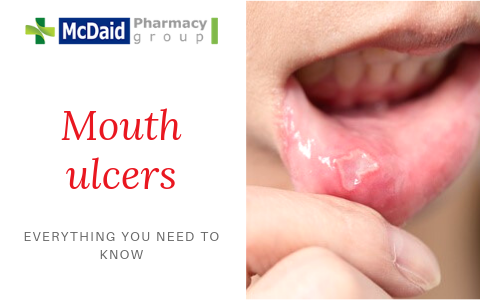Background
Aphthous ulcers, more commonly known as mouth ulcers, is a collective term used to describe various different clinical presentations of superficial painful oral lesions that ,Occur in recurrent bouts at intervals between a few days to a few months. The majority of patients (80%) who present in a community pharmacy will have minor aphthous ulcers (MAU). It is the community pharmacists’ role to exclude more serious pathology, for example, systemic causes and carcinoma.
Prevalence and epidemiology
The prevalence and epidemiology of MAU is poorly understood. hey occur in all ages but it has been reported that they are more common in patients aged between 20 and 40, and up to 66% of young adults give a history consistent with MAU. Lifetime prevalence is estimated to affect one in five of the general population.
Aetiology
The cause of MAU is unknown. A number of theories have been put forward to explain why people get MAU, including a genetic link, stress, trauma, food sensitivities, nutritional deficiencies (iron, zinc and vitamin B12) and infection,but none have so far been proven.
Antibacterial agents (e.g. chlorhexidine)
A number of random controlled trials have investigated antibacterial mouthwashes containing chlorhexidine gluconate.
Data from some, but not all studies, have found that they reduced the pain and severity of each episode of ulceration.
Products containing anaesthetic or analgesics
There is very little trial data to support the pain-relieving effect of anaesthetics or analgesics in MAU, apart from choline salicylate. However, these preparations are clinically effective in other painful oral conditions. It is therefore not unreasonable to expect some relief of symptoms to be shown when using these products to treat MAU.
Choline salicylate
Choline salicylate has been shown to exert an analgesic effect in a number of small studies. However, only one study by Reedy (1970) involving 27 patients evaluated choline salicylate in the treatment of oral aphthous ulceration. No significant differences were found between choline
salicylate and placebo in ulcer resolution but choline salicylate was found to be significantly superior to placebo in relieving pain.
Protectants
Orabase is a paste of gelatin, pectin and carmellose sodium, which sticks when it comes in contact with wet mucosal, this is very useful for large ulcers or those which connect/rub with teeth or braces.
Practical prescribing and product selection
Antibacterial agents (e.g. chlorhexidine)
Chlorhexidine (e.g. Corsodyl) mouthwash is indicated as an aid in the treatment and prevention of gingivitis and in the maintenance of oral hygiene, which includes the management of aphthous ulceration. Ten mL of the mouthwash should be rinsed around the mouth for about 1 minute twice a day. It can be used by all patient groups, including those who are pregnant and breastfeeding. Side effects associated with its use include reversible tongue and tooth discolouration, burning of the tongue and taste disturbance.
Choline salicylate (Bonjela Cool)
Adults and children over 16 years old should apply the gel, using a clean finger, over the ulcer when needed, but limit this to every 3 hours. It is a safe medicine and can be given to all patient groups. It is not known to interact with any medicines or cause any side effects.
Local anaesthetics (lidocaine e.g. Anbesol range, Iglu gel, Medijel) and benzocaine (e.g. Oralgel & Oralgel Extra Strength).
All local anaesthetics have a short duration of action; frequent dosing is therefore required to maintain the anaesthetic effect. They are thus best used on a when needed basis although the upper limit on the number of applications allowed does vary depending on the concentration of anaesthetic included in each product. They appear to be free from any drug interactions, have minimal side effects and can be given to most patients. A small percentage of patients might experience a hypersensitivity reaction with lidocaine or benzocaine; this appears to be more common with benzocaine.
Carmellose sodium (Orabase Protective Paste)
Orabase can be applied as frequently as requred. It is important that it is dabbed on, and not rubbed on, for it to stick correctly. Also, patients should be discouraged from putting too much on as the excess can peel off leaving the lesion exposed. There are no apparent interactions, and Orabase can be used in all patient groups
Oral thrush
Background
Oropharyngeal candidiasis (oral thrush) is an opportunistic mucosal infection and is unusual in healthy adults. If oral thrush is suspected in this population community pharmacists should determine if any identifiable risk factors. A healthy adult with no risk factors generally requires referral to the GP.
The very young (neonates) and the very old are most likely to suffer from oral thrush. It has been reported that 5% of newborn infants and 10% of debilitated elderly patients suffer from oral thrush. Most other cases will be associated with underlying pathology such as diabetes, xerostomia (dry mouth), patients who are immunocompromised or be attributable to identifiable risk factors such as recent antibiotic therapy, inhaled corticosteroids, and ill-fitting dentures.
The dose of gel varies dependent on the age of patient. For adults and children over 6 years, the gel should be applied four times a day and those under six the dose is twice a day. The gel should be applied directly to the area with a clean finger. In May 2008 Jansen-Cilag, the manufacturers of Daktarin, chose to vary the Summary of Product Characteristics (SPC) to recommend that it is not used in infants under 4 months and only with care below the age of 6 months. This change appears to originate from a published report (De Vries et al 2006) documenting a 17-day-old baby who choked when exposed to miconazole oral gel.
It can occasionally cause nausea and vomiting. The manufacturers state that it can interact with a number of medicines, namely mizolastine, cisapride, triazolam, midazolam, quinidine, pimozide, HMG-CoA reductase inhibitorsand anticoagulants.
However, there is a lack of published data to determine how clinically significant these interactions are except with warfarin. Co-administration of warfarin with miconazole increases warfarin levels markedly hence
DO NOT GIVE WARFARIN WITH DAKTARIN
The manufacturers advise that Daktarin should be avoided in pregnancy but published data does not support an association between miconazole and congenital defects. It appears to be safe to use whilst breastfeeding.
HINTS AND TIPS -DAKTARIN
- Application of Daktarin – Patients should be advised to hold the gel in the mouth for as long as possible to increase contact time between the medicine and the infection
- Duration of treatment- Treatment should be continued for up to 2 days after the symptoms have cleared to prevent relapse and reinfection
- Patient acceptability – Gel is flavoured orange to make retention in the mouth more acceptable to patients



